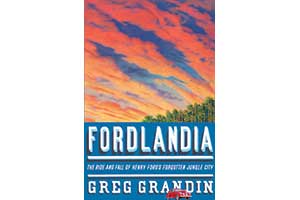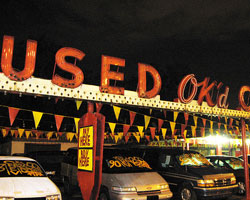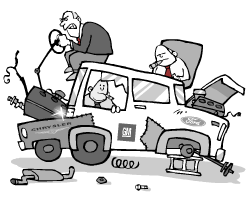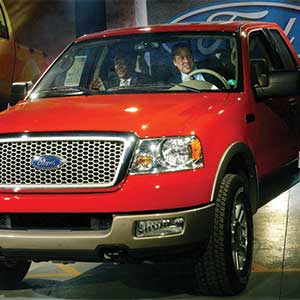This story first appeared on the TomDispatch website.
The empire ends with a pull out. Not, as many supposed a few years ago, from Iraq. There, as well as in Afghanistan, we are mulishly staying the course, come what may, trapped in the biggest of all the “too-big-to-fail” boondoggles. But from Detroit.
Of course, the real evacuation of the Motor City began decades ago, when Ford, General Motors, and Chrysler started to move more and more of their operations out of the downtown area to harder to unionize rural areas and suburbs, and, finally, overseas. Even as the economy boomed in the 1950s and 1960s, 50 Detroit residents were already packing up and leaving their city every day. By the time the Berlin Wall fell in 1989, Detroit could count tens of thousands of empty lots and over 15,000 abandoned homes. Stunning Beaux Arts and modernist buildings were left deserted to return to nature, their floors and roofs covered by switchgrass. They now serve as little more than ornate bird houses.
In mythological terms, however, Detroit remains the ancestral birthplace of storied American capitalism. And looking back in the years to come, the sudden disintegration of the Big Three this year will surely be seen as a blow to American power comparable to the end of the Raj, Britain’s loss of India, that jewel in the imperial crown, in 1948. Forget the possession of a colony or the bomb, in the second half of the twentieth century, the real marker of a world power was the ability to make a precision V-8.
There have been dissections aplenty of what went wrong with the U.S. auto industry, as well as fond reminiscences about Detroit’s salad days, about outsized tailfins and double-barrel carburetors. Last year, the iconic Clint Eastwood even put the iconic white auto worker to rest in his movie Gran Torino. Few of these postmortems have conveyed, however, just how crucial Detroit was to U.S. foreign policy — not just as the anchor of America’s high-tech, high-profit export economy, but as a confirmation of our sense of ourselves as the world’s premier power (although in linking Detroit’s demise to the blowback from President Nixon’s illegal war in Laos, Eastwood at least came closer than most).
Detroit not only supplied a continual stream of symbols of America’s cultural power, but offered the organizational know-how necessary to run a vast industrial enterprise like a car company — or an empire. Pundits love to quote GM President “Engine” Charlie Wilson, who once famously said that he thought what was good for America “was good for General Motors, and vice versa.” It’s rarely noted, however, that Wilson made his remark at his Senate confirmation hearings to be Dwight D. Eisenhower’s Secretary of Defense. At the Pentagon, Wilson would impose GM’s corporate bureaucratic model on the armed forces, modernizing them to fight the Cold War.
After GM, it was Ford’s turn to take the reins, with John F. Kennedy tapping its CEO Robert McNamara and his “whiz kids” to ready American troops for a “long twilight struggle, year in and year out.” McNamara used Ford’s integrated “systems management” approach to wage “mechanized, dehumanizing slaughter,” as historian Gabriel Kolko once put it, from the skies over Vietnam, Laos, and Cambodia.
Perhaps, then, we should think of the ruins of Detroit as our Roman Forum. Just as Rome’s triumphal arches still remind us of its bygone imperial victories in Mesopotamia, Persia, and elsewhere, so Motown’s dilapidated buildings today invoke America’s fast slipping supremacy.
Among the most imposing is Henry Ford’s Highland Park factory, shuttered since the late 1950s. Dubbed the Crystal Palace for its floor to ceiling glass walls, it was here that Ford perfected assembly-line production, building up to 9,000 Model Ts a day — a million by 1915 — catapulting the United States light-years ahead of industrial Europe.
 It was also here that Ford first paid his workers five dollars a day, creating one of the fastest growing and most prosperous working-class neighborhoods in all of America, filled with fine arts-and-crafts style homes. Today, Highland Park looks like a war zone, its streets covered with shattered glass and lined with burnt-out houses. More than 30% of its population lives in poverty, and you don’t want to know the unemployment numbers (more than 20%) or the median yearly income (less than $20,000).
It was also here that Ford first paid his workers five dollars a day, creating one of the fastest growing and most prosperous working-class neighborhoods in all of America, filled with fine arts-and-crafts style homes. Today, Highland Park looks like a war zone, its streets covered with shattered glass and lined with burnt-out houses. More than 30% of its population lives in poverty, and you don’t want to know the unemployment numbers (more than 20%) or the median yearly income (less than $20,000).
There is one reminder that it wasn’t always so. A small historical-register plaque outside the Ford factory reads: “Mass production soon moved from here to all phases of American industry and set the pattern of abundance for 20th Century living.”
America in the Amazon
To truly grasp how far America has fallen from the heights of its industrial grandeur — and to understand how that grandeur led to stupendous acts of folly — you should tour another set of ruins far from the Midwest rustbelt; they lie, in fact, deep (and nearly forgotten) in, of all places, the Brazilian Amazon rainforest. There, overrun by tropical vines, sits Henry Ford’s testament to the belief that the American Way of Life could easily be exported, even to one of the wildest places on the planet.
Ford owned forests in Michigan as well as mines in Kentucky and West Virginia, which gave him control over every natural resource needed to make a car — save rubber. So in 1927, he obtained an Amazonian land grant the size of a small American state. Ford could have simply set up a purchasing office there, and bought rubber from local producers, leaving them to live their lives as they saw fit. That’s what other rubber exporters did.
Ford, however, had more grandiose ideas. He felt compelled to cultivate not only “rubber but the rubber gatherers as well.” So he set out to overlay Americana on Amazonia. He had his managers build Cape Cod-style shingled houses for the Brazilian work force he hired. He urged them to tend flower and vegetable gardens and eat whole wheat bread, unpolished rice, canned Michigan peaches, and oatmeal. He dubbed his jungle town, with suitable pride, Fordlandia.
It was the 1920s, of course, and so his managers enforced alcohol Prohibition, or at least tried to, though it wasn’t a Brazilian law, as it was in the United States at the time. On weekends, the company organized square dances and recitations of the poetry of Henry Longfellow. The hospital Ford had built in the town offered free health care for workers and visitors alike. It was designed by Albert Kahn, the renowned architect who built a number of Detroit’s most famous buildings, including the Crystal Palace. Fordlandia had a central square, sidewalks, indoor plumbing, manicured lawns, a movie theater, shoe stores, ice cream and perfume shops, swimming pools, tennis courts, a golf course, and, of course, Model Ts rolling down its paved streets.
The clash between Henry Ford — the man who reduced industrial production to its simplest motions in order to produce a series of infinitely identical products, the first indistinguishable from the millionth — and the Amazon, the world’s most complex and diverse ecosystem, was Chaplinesque in its absurdity, producing a parade of mishaps straight out of a Hollywood movie. Think Modern Times meets Fitzcarraldo. Brazilian workers rebelled against Ford’s Puritanism and nature rebelled against his industrial regimentation. Run by incompetent managers who knew little about rubber planting much less social engineering, Fordlandia in its early years was plagued by vice, knife fights, and riots. The place seemed less Our Town than Deadwood, as brothels and bars sprawled around its edges.
Ford did eventually manage to get control over his namesake fiefdom, but because he insisted that his managers plant rubber trees in tight rows — back in his Detroit factories, Ford famously crowded machines close together to reduce movement — he actually created the conditions for the explosive growth of the bugs and blight that feed off rubber, and these eventually laid waste to the plantation. Over the course of nearly two decades, Ford sank millions upon millions of dollars into trying to make his jungle utopia work the American way, yet not one drop of Fordlandia latex ever made its way into a Ford car.
The eeriest thing of all is this: Today, the ruins of Fordlandia look a lot like those in Highland Park, as well as in other rustbelt towns where neighborhoods that once hummed with life centered on a factory are now returned to weed. There is, in fact, an uncanny resemblance between Fordlandia’s rusting water tower, broken-glassed sawmill, and empty power plant and the husks of the same structures in Iron Mountain, a depressed industrial city on Michigan’s Upper Peninsula that also used to be a Ford town.
In the Amazon, Albert Kahn’s hospital has collapsed, the jungle has reclaimed the golf course and tennis courts, and bats have taken up residence in houses where American managers once lived, covering their plaster walls with a glaze of guano. No commemorative plaque marks its place in history, but Fordlandia, no less than the wreck of Detroit, is a monument to the titans of American capital — none more titanic than Ford — who believed that the United States offered a universal, and universally acknowledged, model for the rest of humanity.
Errand into the Wilderness
It would be easy to read the story of Fordlandia as a parable of arrogance. With a surety of purpose and incuriosity about the world that seem all too familiar, Ford deliberately rejected expert advice and set out to turn the Amazon into the Midwest of his imagination. The more the project failed on its own terms — that is, to grow rubber — the more Ford company officials defended it as a civilizational mission; think of it as a kind of distant preview of the ever expanding set of justifications for why the U.S. invaded Iraq six years ago. Yet Fordlandia cuts deeper into the marrow of the American experience than that.
Over 50 years ago, the Harvard historian Perry Miller gave a famous lecture which he titled “Errand into the Wilderness.” In it, he tried to explain why English Puritans lit out for the New World to begin with, as opposed to, say, going to Holland. They went, Miller suggested, not just to escape the corruptions of the Church of England but to complete the Protestant reformation of Christendom that had stalled in Europe.
The Puritans did not flee to the New World, Miller said, but rather sought to give the faithful back in England a “working model” of a purer community. Put another way, central from the beginning to American expansion was “deep disquietude,” a feeling that “something had gone wrong” at home. With the Massachusetts Bay Colony just a few decades old, a dissatisfied Cotton Mather began to learn Spanish, thinking that a better “New Jerusalem” could be raised in Mexico.
The founding of Fordlandia was driven by a similar restlessness, a chafing sense, even in the good times, the best of times, that “something had gone wrong” in America. When Ford embarked on his Amazon adventure, he had already spent the greater part of two decades, and a large part of his enormous fortune, trying to reform American society. His frustrations and discontents with domestic politics and culture were legion. War, unions, Wall Street, energy monopolies, Jews, modern dance, cow’s milk, both Theodore and Franklin Roosevelt, cigarettes, and alcohol were among his many targets and complaints. Yet churning beneath all these imagined annoyances was the fact that the force of industrial capitalism he had helped unleash was undermining the world he hoped to restore.
Ford preached with a pastor’s confidence his one true idea: ever increasing productivity combined with ever increasing pay would both relieve human drudgery and create prosperous working-class communities, with corporate profits dependent on the continual expansion of consumer demand. “High wages,” as Ford put it, to create “large markets.” By the late 1920s, Fordism — as this idea came to be called — was synonymous with Americanism, envied the world over for having apparently humanized industrial capitalism.
But Fordism contained within itself the seeds of its own undoing: the breaking down of the assembly process into smaller and smaller tasks, combined with rapid advances in transportation and communication, made it easier for manufacturers to break out of the dependent relationship established by Ford between high wages and large markets. Goods could be made in one place and sold somewhere else, removing the incentive employers had to pay workers enough to buy the products they made.
In Rome, the ruins came after the empire fell. In the United States, the destruction of Detroit happened even as the country was rising to new heights as a superpower.
Ford sensed this unraveling early on and responded to it, trying at least to slow it in ever more eccentric ways. He established throughout Michigan a series of decentralized “village-industries” designed to balance farm and factory work and rescue small-town America. Yet his pastoral communes were no match for the raw power of the changes he had played such a large part in engendering. So he turned to the Amazon to raise his City on a Hill, or in this case a city in a tropical river valley, pulling together all the many strains of his utopianism in one last, desperate bid for success.
Nearly a century ago, the journalist Walter Lippmann remarked that Henry Ford’s drive to make the world anew represented a common strain of “primitive Americanism,” reinforced by a confidence born of unparalleled achievement. He then followed with a question meant to be sarcastic but which was, in fact, all too prophetic: “Why shouldn’t success in Detroit assure success in front of Baghdad?” We know the ruination that befell Detroit. Whither Baghdad? Whither America?
Greg Grandin is a professor of history at New York University and author of a number of books, most recently, Fordlandia: The Rise and Fall of Henry Ford’s Forgotten Jungle City (Metropolitan 2009).


















